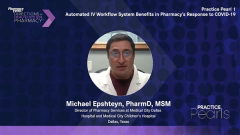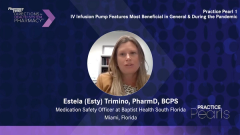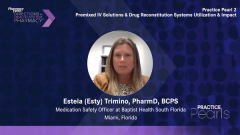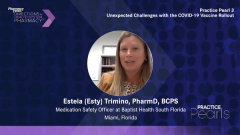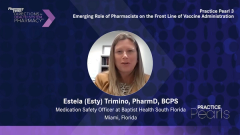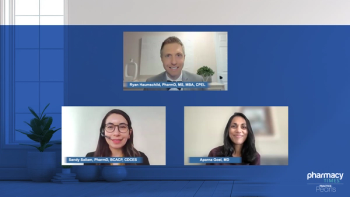
Practice Pearl 3: Unexpected Challenges with the COVID-19 Vaccine Rollout
Health system pharmacists discuss challenges with the COVID-19 vaccine rollout, such as having multiple vaccine types and lot numbers on hand and appointment no-shows
Episodes in this series

Madeline Camejo, PharmD, MS: Esty, what were some of the unexpected challenges you experienced during the COVID-19 vaccine rollout at Baptist [Health South Florida]? One of the things I remember is, when we were creating the schedules for employees to come in, 1 of the things is that you were mixing for a certain number. Let’s say 300 employees that were supposed to show up for the day and only 250 showed up. One of the things that we never expected in the beginning, which was a big challenge, is how do you deal with the no-shows? What do you do with the vaccines that you had to mix but now had to throw out? One of the things we ended up doing is calling all kinds of people. But what other challenges did you have to deal with on the fly, especially as you get 1 lot this day and another lot the next day. We were trying to change lot numbers, trying to do things on the fly. Those were some things that I remember. What were some of the other things you experienced in the pod?
Estela Trimino, PharmD, BCPS: One of the ones that I very much remember is when we have 3 lot numbers of vaccines, toward that last couple of weeks we had to stop and set up tables. Or when you have 2 products—we had the Moderna and Pfizer vaccines. We were doing double vaccines. Some of these appointments for the second vaccine were at the same time. It was difficult. In a room there were about 13 vaccinators. Lots of people in line. One of the biggest things unexpected is that we have both vaccines on the same day. How are we going to do this? We divided the room out, made sure that mixers in the area were the pharmacy—I call it the pharmacy Hilton IV [intravenous] room, which is where the pharmacy production of the vaccines were. We had about 7 mixers at a time in that room, in that pod. We made sure that half the room was doing 1 vaccine vs the other.
Then we got to a point that we had both vaccines and then different lot numbers. We had to be sure because our inputters into Florida SHOTS wanted to have the right lot number. We needed to be sure we had the right product that we were administering to keep that lot number consistent with what the patient was receiving and the vaccine. We wanted to keep it straight. One of the unexpected things is when we were vaccinating and 1 was 21 days vs 28. They bunched up together. That was a big deal. But we got through it. We did find a system, and it worked. We had multiple days like that, and more no-shows than we expected on certain days and then finding who else was on that list who could come in right away before the medication expired or we closed the site. That was challenging because it was down to the wire, right before we closed. We didn’t want to waste any of those vaccines that were already made. That was unexpected and challenging.
Madeline Camejo, PharmD, MS: Did you have the same in Texas? In Florida, we got Pfizer and then suddenly the states changed, and we got Moderna. The challenge was, we had Moderna to do for a couple of weeks and then changed back to Pfizer. It was interesting what was happening here. How was that in Texas?
Michael Epshteyn, PharmD, MSM:Pretty much similar to what you guys have already described. Our biggest, unexpected challenge was, as the word started to get out that the second-dose adverse effects were worse than the first, some patients did not want to come back for the second dose. That was an unexpected challenge. We had more cancellations for second-dose appointments than we did for the first ones. Everybody was excited about the first one. That was an unexpected challenge, but we quickly adjusted. We had more vials of vaccine left over from second doses. We kept those vials, and we were able to consolidate them and offer it to others who wanted the vaccine. That’s how we had to deal with that challenge. But it’s not that 100% of people who received the first dose wouldn’t come for the second dose, but 1 was that they were scared the adverse effects of the vaccine would be more severe.
Transcript edited for clarity.
Newsletter
Stay informed on drug updates, treatment guidelines, and pharmacy practice trends—subscribe to Pharmacy Times for weekly clinical insights.

